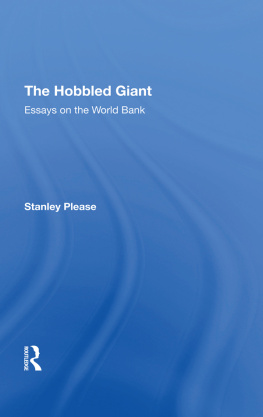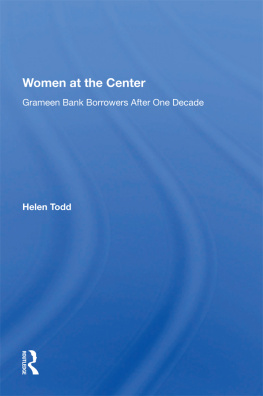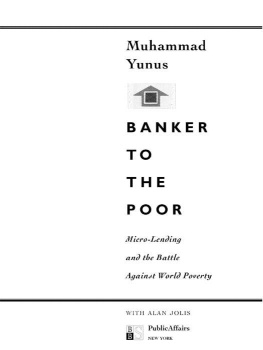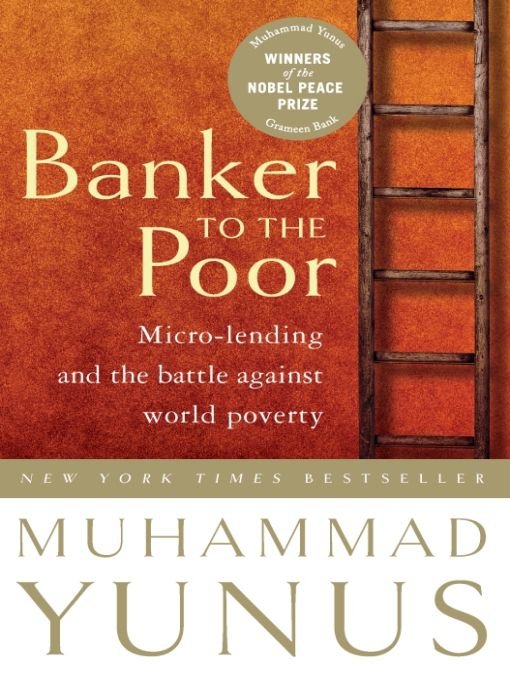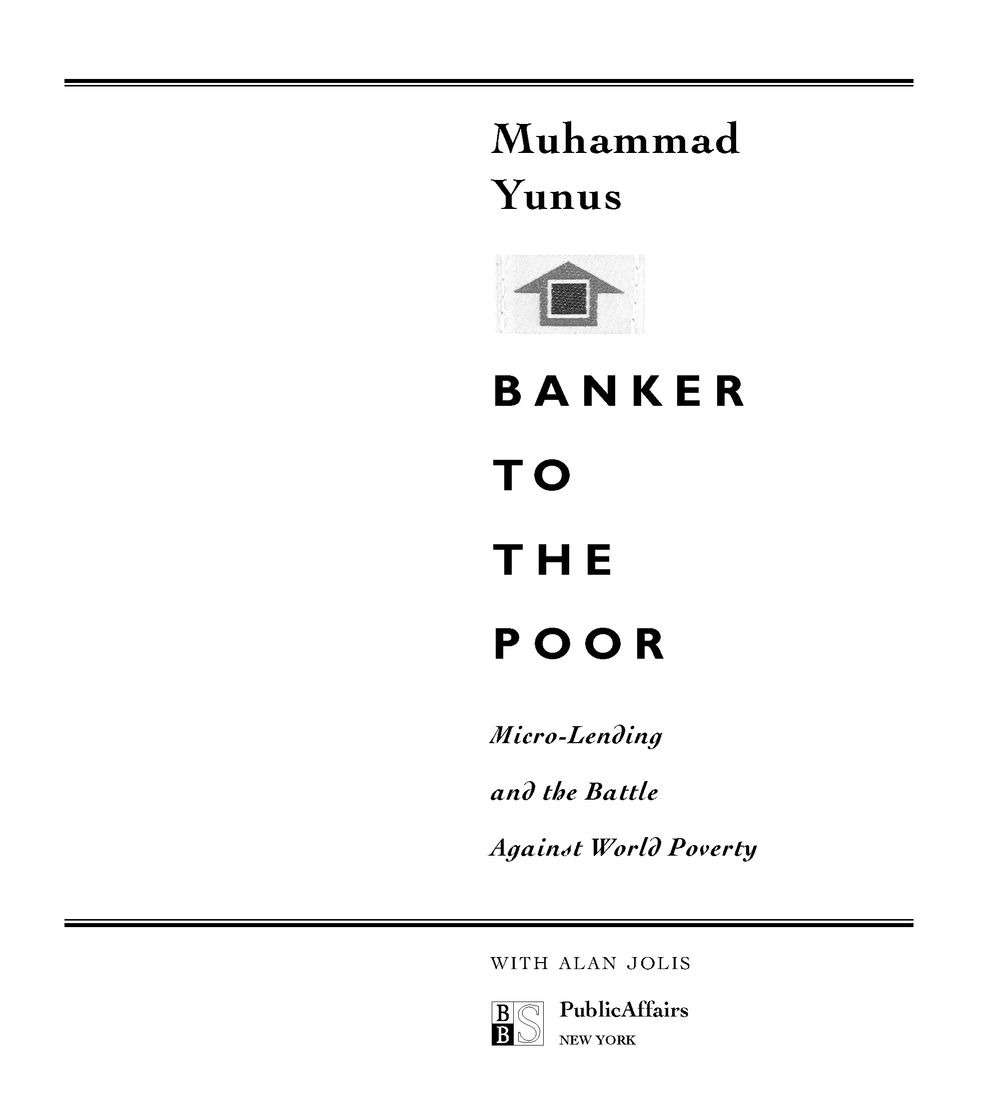Table of Contents
Praise forBanker to the Poor
By giving poor people the power to help themselves, Dr. Yunus has offered them something far more valuable than a plate of foodsecurity in its most fundamental form.
President Jimmy Carter
[Yunuss] ideas have already had a great impact on the Third World, and ... hearing his appeal for a poverty-free world from the source itself can be as stirring as that all-American myth of bootstrap success.
The Washington Post
I only wish every nation shared Dr. Yunuss and the Grameen Banks appreciation of the vital role that women play in the economic, social, and political life of our societies.
Hillary Rodham Clinton
The [Grameen Bank] has become a mecca for development economists and is being copied around the world.
The Economist
Muhammad Yunus is a practical visionary who has improved the lives of millions of people in his native Bangladesh and elsewhere in the world. Banker to the Poor [is] well-reasoned yet passionate.
Los Angels Times
Microcredit has proved its worth among the poorest.
The International Herald Tribune
Yunus shows that micro-lending can be much more effective than unwieldy and expensive aid programs.
Publishers Weekly
Banker to the Poor offers a challenging look at the way we reinforce povertyoffering welfare instead of encouraging self-sufficiency, only offering loans to candidates with a safe risk factor (what Yunus calls a financial apartheid), believing that the poor lack skills and can only be worthwhile contributors to the economy after extensive training. Yunus lays out a convincing argument for the need to nourish and better understand the peoples economy.... A hopeful and inspiring read, even for those who, like me, have little prior knowledge or understanding of financing and credit loans.
Vision Magazine
An inspiring memoir of the birth of microcredit, written in a conversational tone that makes it both moving and enjoyable to read.
Election2004.com
Fascinating.
Hungry Mind Review
A fascinating and compelling account by someone who decided to make a difference, and did.
Choice
Acknowledgments
For their assistance in the preparation of this edition of the book, I would like to acknowledge Alex Counts, President of Grameen Foundation USA, Kate Darnton of PublicAffairs, and for his generous support, George Stephanopoulos.
INTRODUCTION
In the year 1974 Bangladesh fell into the grip of famine.
The university where I taught and served as head of the Economics Department was located in the southeastern extremity of the country, and at first we did not pay much attention to the newspaper stories of death and starvation in the remote villages of the north. But then skeleton-like people began showing up in the railway stations and bus stations of the capital, Dhaka. Soon this trickle became a flood. Hungry people were everywhere. Often they sat so still that one could not be sure whether they were alive or dead. They all looked alike: men, women, children. Old people looked like children, and children looked like old people.
The government opened gruel kitchens. But every new gruel kitchen ran out of rice. Newspaper reporters tried to warn the nation of the extent of the famine. Research institutions collected statistics on the sources and causes of the sudden migration to the cities. Religious organizations mobilized groups to pick up the dead bodies from the streets and bury them with the proper rites. But soon the simple act of collecting the dead became a larger task then these groups were equipped to handle.
The starving people did not chant any slogans. They did not demand anything from us well-fed city folk. They simply lay down very quietly on our doorsteps and waited to die.
There are many ways for people to die, but somehow dying of starvation is the most unacceptable of all. It happens in slow motion. Second by second, the distance between life and death becomes smaller and smaller, until the two are in such close proximity that one can hardly tell the difference. Like sleep, death by starvation happens so quietly, so inexorably, one does not even sense it happening. And all for lack of a handful of rice at each meal. In this world of plenty, a tiny baby, who does not yet understand the mystery of the world, is allowed to cry and cry and finally fall asleep without the milk she needs to survive. The next day she may not have the strength to continue living.
I used to feel a thrill at teaching my students the elegant economic theories that could supposedly cure societal problems of all types. But in 1974, I started to dread my own lectures. What good were all my complex theories when people were dying of starvation on the sidewalks and porches across from my lecture hall? My lessons were like the American movies where the good guys always win. But when I emerged from the comfort of the classroom, I was faced with the reality of the city streets. Here good guys were mercilessly beaten and trampled. Daily life was getting worse, and the poor were growing even poorer.
Nothing in the economic theories I taught reflected the life around me. How could I go on telling my students make-believe stories in the name of economics? I wanted to become a fugitive from academic life. I needed to run away from these theories and from my textbooks and discover the real-life economics of a poor persons existence.
I was lucky that the village of Jobra happened to be close to the campus. In 1958, Field Marshall Ayub Khan, then president of Pakistan, had taken power in a military coup. Because of his fear of rebellious students, he decreed that all new universities be situated away from urban centers. His fear of political agitation meant that the new Chittagong University, where I was teaching, was built in a hilly section of the rural Chittagong District, next to Jobra village.
The proximity of Jobra made it a perfect choice for my new course of study. I decided I would become a student all over again, and the people of Jobra would be my professors. I vowed to learn as much as possible about the village. Traditional universities had created an enormous distance between their students and the reality of everyday life in Bangladesh. Instead of traditional book learning, I wanted to teach my university students how to understand the life of one single poor person. When you hold the world in your palm and inspect it only from a birds eye view, you tend to become arrogantyou do not realize that things get blurred when seen from an enormous distance. I opted instead for the worms eye view. I hoped that if I studied poverty at close range, I would understand it more keenly.
My repeated trips to the villages around the Chittagong University campus led me to discoveries that were essential to establishing the Grameen Bank. The poor taught me an entirely new economics. I learned about the problems that they face from their own perspective. I tried a great number of things. Some worked. Others did not. One that worked well was to offer people tiny loans for self-employment. These loans provided a starting point for cottage industries and other income-generating activities that used the skills the borrowers already had.


